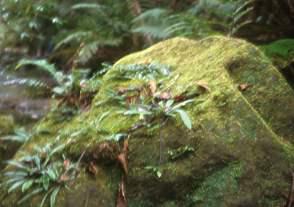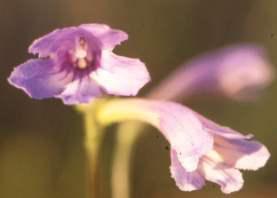Streptocarpus lilliputana
Streptocarpus lilliputana D.U.Bellstedt & T.J.Edwards
Family: Gesneriaceae
Common names:
Introduction
This is a recently discovered Streptocarpus, found in only a few locations in Pondoland that are under threat.

Description
Description
Streptocarpus lilliputana is a perennial cliff dweller, with a poorly developed rhizome because it is usually found in rock seepages. When in flower, it may have one to a few flowers. These flowers are purple, approximately 50 mm long, with the tube dominated by seven, broad, deep violet stripes within the tube. The leaves are oblong, ± 59-90 x 15-20 mm, and are dark green with a distinct sheen at the top and light green below. The sheen and size of the sparsely hairy leaves, the spherical shape of the pollen grains and the shape of the stigma are what distinguishes S. lilliputana from other gesneriads and make it rather unique. The flowers of S. lilliputana are similar to those of S. modestus and both species occur in the same general area; however, no evidence of hybridization has been documented.

Conservation Status
Status
Streptocarpus lilliputana was first brought to my attention while discussing the assessments and Red Data List statuses of unthreatened Streptocarpus taxa. Jaco Truter (pers. comm.) thought that S. lilliputana was a highly localized species and should be on the Red Data List of South Africa.
The first ever known locality with a Streptocarpus lilliputana population is currently threatened by habitat destruction. At this site, nearby locals are utilizing the area to harvest fuel wood. This locality, on the lower reaches of the Laputana River Gorge, is seriously threatened because the trees that provide the essential forest habitat needed by S. lillputana are being removed. The main potential threat to this species at the remaining two localities is drought (J. Truter pers. comm. 2005), which normally decreases seed production and consequently results in low population numbers in the year following a drought. This combination of threats, the restricted distribution and the number of localities in which this species can be found, has led to S. lilliputana being assessed as Vulnerable using the latest IUCN criteria, version 3.1 (J. Truter, J. Edwards & F. Daniels pers. comm. 2005). There are no specific conservation efforts for this species, mainly because it occurs in the Pondoland area that has now been recognized as a global hotspot.
Distribution and habitat
Distribution description
S. lilliputana is especially rare and is it is known only from the forested river gorges of the Lupatana and Mkozi Rivers in the Pondoland area, a biodiversity hotspot. Its total known distribution range is much smaller than 100 km square and, like most plants within the genus Streptocarpus, this species is highly habitat specific and only occurs when the conditions for its growth are met. Thus, S. lilliputana grows only in deep shade in sparse colonies on rock seepages in forested areas. This perennial forb with one to a few inflorescences, normally flowers from November to February and immature fruits can be seen from late January.

Derivation of name and historical aspects
History
The name Streptocarpus lilliputana is derived from a combination of lilliputian (meaning dwarf in Greek) and the Lupatana River, the type locality of this recently discovered species (Bellstedt & Edwards 2004). S. lilliputana 's rarity and rather restricted distribution range and its occurrence in the under-collected Pondoland area has probably been the reason why there is also very little published information about its ecology. Currently S. lilliputana is only known from three localities.
Ecology
Ecology
As this species has been only recently described, there is very little information available on its ecology. Its pollinator is unknown to me, but its small seeds are wind dispersed. This lack of information would make this species a good plant to investigate further by honours or masters students.

Growing Streptocarpus lilliputana
Grow
As this species has only been recently discovered and described there is very little information on its horticultural success. Its rarity is another reason it has not yet been propagated for general garden use; its occurrence in only a few localities, makes it harder to have a mass seed collection from the wild population. This species bears rather beautiful flowers, and prefers shady areas.
References
- Bellstedt, D.U. & Edwards, T.J. 2004. A new species of Streptocarpus (Gesneriaceae) from the Pondoland coast, South Africa. Edinburgh Journal of Botany 60: 409-414.
- Hilliard, O.M. & Burtt, B.L. 1971. Streptocarpus: an African plant study. University of Natal Press, Pietermaritzburg.
Credits
Fahiema Daniels
Pretoria TSP
January 2006
Plant Attributes:
Plant Type: Perennial
SA Distribution:
Soil type: Sandy, Loam
Flowering season: Early Summer, Late Summer, Autumn
PH: Acid, Neutral
Flower colour: White
Aspect: Shade
Gardening skill: Challenging
Special Features:
Horticultural zones







Rate this article
Article well written and informative
Rate this plant
Is this an interesting plant?
Login to add your Comment
Back to topNot registered yet? Click here to register.